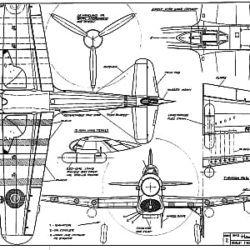Hawker Typhoon History
The Hawker Typhoon was evolved by Sydney Camm’s design staff at Hawker Aircraft in response to Air Ministry Specification F.18/37, which was for an interceptor capable of combating such heavily armed and armoured escort fighters as the Messerschmitt Bf 110.
Such an aeroplane was inevitably heavier than either the Hawker Hurricane or the Supermarine Spitfire, and to provide a comparable performance the powerplants selected were the new Napier Sabre H-type in-line engine and the X-type Rolls Royce Vulture, both of which promised to develop some 2,000 hp. Prototypes were completed with both types of engine; the Vulture-engined design, named Tornado, was later abandoned when Vulture production was curtailed.
With Sabre engine, the aircraft was named Typhoon, and the first of two prototypes (P 5212) was flown on 24 February 1940. The Hawker Typhoon was a low-wing monoplane and the first Hawker product featuring stressed-skin construction. It also mounted widetrack landing gear, and initial models had a cabin-type cockpit with a side door. The aircraft flew well at low altitudes but demonstrated dismal climbing capacity.
Early service trials and squadron experience were far too short of being satisfactory, and it is conceivable that the Typhoon’s future career might soon have ended but for the appearance in 1941 of the Focke-Wulf Fw 190 in hit-and-run raids across the English Channel. The Fw 190 could outmanoeuvre all other British fighters, including the Spitfire V, and the Typhoon was the only effective means of stopping it.
The early Hawker Typhoon IAs carried six 0.303 in Browning guns in each wing, but these were replaced in the Mk IB by four wing-mounted 20 mm cannon, which became the Typhoon’s regular fixed armament. The fighter was unspectacular at altitude, but its clashes with the Fw 190 had revealed outstanding strength and agility at low level, and from this stemmed the type’s widespread use – and success – as a ground attack aircraft. After extensive weapons trials during 1942, Typhoons began to be fitted for operational use in the following year with underwing rails for eight rocket projectiles, the chief weapon employed by the type. Before and after the invasion of Europe, rocket-armed Typhoons attacked land and sea targets in the Channel and in Belgium, France and the Netherlands.
Attacking in waves, the Hawker Typhoon aircraft proved particularly devastating against German Panzer divisions at Falaise, destroying 137 tanks in one day! They were all retired by 1945 as the most effective ground-attack aircraft of the war. A total of three thousand three hundred and thirty Typhoons were built, all by Gloster except for the two prototypes, five Mk IAs and ten Mk IBs.





